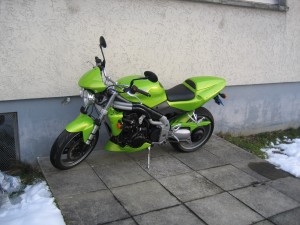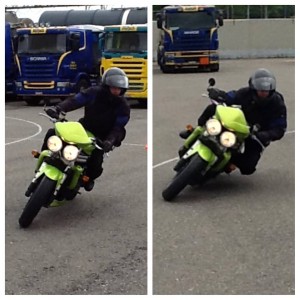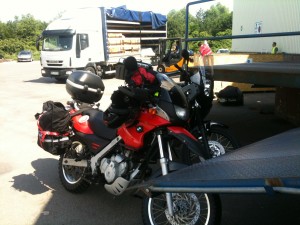As soon as I decided to do the trip by motorcycle I started looking for a suitable steed. My first and only motorbike up to this point was my trusty Triumph Street Triple anno 2004. Back then I was young(er) and (more) naive, and I chose it the way young and naive guys would choose a woman, which is to say on looks alone. I was concerned with image and appearances back then, and so I was wooed by the aggressive styling and british breeding. It did not help that the unscrupulous salesman told me that it is a perfectly good beginner’s bike. As a result it took me two falls, several near death experiences, two instructors, two exams, and probably twice the number of expensive lessons to get my mastery of the vehicle to the point where I was able to pass the strict Swiss license exam. In fact I only got the license because on my second try I did the exam on a tame rented Honda street bike with only half the engine volume, which handled like a bicycle in comparison.
and so I was wooed by the aggressive styling and british breeding. It did not help that the unscrupulous salesman told me that it is a perfectly good beginner’s bike. As a result it took me two falls, several near death experiences, two instructors, two exams, and probably twice the number of expensive lessons to get my mastery of the vehicle to the point where I was able to pass the strict Swiss license exam. In fact I only got the license because on my second try I did the exam on a tame rented Honda street bike with only half the engine volume, which handled like a bicycle in comparison.
Fast forward 8 years or so … today I ride my triumph as if it were a bicycle, having grown perfectly accustomed to it after all this time of three season daily riding. I have ridden it on dirt roads, scraped its belly on steep kerbs, and recently even mastered the hanging off style of cornering.  I now have a fairly good understanding of what it is good at and what not so much. Probably the most annoying aspect of the bike has nothing to do with the handling but rather the way it is made. I tried to maintain it myself rather than take it to the Triumph dealer’s workshop for every little thing, but this has proven to be a futile endeavor. Like modern cars, the bike is not intended to be user serviced. This starts with the lack of a center stand which makes a bike stand be just the first of a host of specialized tools one would need to buy to be able to do much of anything. As a result my tinkering has not gone much further than removing the battery over the iciest winter months. Not to mention that the local Triumph dealers are absolutely unhelpful when it comes to learning how to maintain the bike.
I now have a fairly good understanding of what it is good at and what not so much. Probably the most annoying aspect of the bike has nothing to do with the handling but rather the way it is made. I tried to maintain it myself rather than take it to the Triumph dealer’s workshop for every little thing, but this has proven to be a futile endeavor. Like modern cars, the bike is not intended to be user serviced. This starts with the lack of a center stand which makes a bike stand be just the first of a host of specialized tools one would need to buy to be able to do much of anything. As a result my tinkering has not gone much further than removing the battery over the iciest winter months. Not to mention that the local Triumph dealers are absolutely unhelpful when it comes to learning how to maintain the bike.
It was clear to me that out in the boonies there may not be an official manufacturer-authorized service station around, so I will need to be able to perform routine maintenance and small repairs myself. The precondition to doing this is a bike that is built to permit it. This became the number one requirement for choosing my ride. The number two requirement was price: I now had a family to support, we were shopping for a house, and it was clear I did not have the levels of disposable income I once … ahem … disposed over. So I was looking for something as cheap as possible that would still reliably get me where I needed to go. Of course the trip should still be fun in the motorcycling sense of the word while lugging a lot of luggage around, so I ruled out anything under 600 cc.
With these requirements in mind I started surfing used vehicle websites. The first thing I was contemplating, and even took for a test ride was a Suzuki DR 650 for 2500 CHF. It was the perfect bike in terms of maintainability: A prehistoric design carburated single cylinder engine that did not have any of the modern day bells and whistles that make things nontrivial. On the other hand this engine was quite weak compared to ‘modern’ 600 cc single cylinders with high compression ratios and fuel injection, acceleration was so-so. I also thought the brakes were on the weak side, and the rear sub-frame did not look enthusiastic to carry a lot of load. Wind protection was also nonexistent. I read about quite a few people who take such a bike on long journeys with a lot of success, but they tend to have made serious modifications to the stock setup.
In the end I abandoned the Suzuki in favor of a BMW 650 GS. This one has a single cylinder fuel injected, high compression rotax engine, but the rest of the bike is free of electronic schnickschnack. I am talking about the ABS-less model from 2000. This BMW is actually German in name only, as it was built by Aprilia using an Austrian-made engine. The Italian / multinational heritage becomes obvious as soon as one tries to simply remove the fairings. At least three of four different screw head types are used seemingly randomly for similar sized screws all over the machine, annoyingly enough.
Over the course of some winter months I spent my daily free time (which is typically between 10 PM, the time we put my son to bed, and midnight) to teach myself some basic maintenance skills. I did buy a semi-official repair manual for the bike, but this glossed over too many details. In the end Youtube and the enthusiast maintained GS FAQ were invaluable in this process. In the end I know how to change the oil, replace the air filter, change the brake pads, change the battery, take out the wheels, and change the tires and inner tubes. I also mounted a luggage frame most of the way before giving up and asking a professional mechanic for help. 🙂 I did not go as far as change my own brake fluid or calibrate the engine valves, but I am pretty sure I could figure these things out too if I had enough time and motivation. I should not need to do those things however for this trip. By far the most annoying aspect of this work was how many different tools one needs. It is obvious that it never occurred to the engineers who came up with this bike that their creativity with fasteners may require that travelers will have to drag half the bike’s weight in tools along with them for journeys to remote locations.
I rode the bike a fair bit during the following spring, and it is really quite comfortable, especially thanks to the custom gel seat and custom windshield that came with it. We were actually going to try the bikes in a longer weekend camping outing but in the end we did not have time for this. The only longer trip I took with it so far was to drive it to Germany and box it up for the logistics company that was going to ship it to Mongolia. On this trip I managed to melt the loose ends of the fastening cables of my soft luggage to the hot exhaust on both sides of the bike. That was annoying and a thing to try to avoid going forward.
Here is a picture of the BMW waiting to be packed up and shipped off. More about this very painful experience later.

